Physical Address
304 North Cardinal St.
Dorchester Center, MA 02124
The pineal gland is a unique midline organ located posterior to the third ventricle in the quadrigeminal cistern. It is surrounded by the splenium of the corpus callosum above, the thalami laterally, and the quadrigeminal plate and vermis below, together delineating the pineal region. Histologically, human pineal gland parenchyma is mainly composed of pineocytes with a few supportive astrocytes and is subdivided into lobules by the pial layer (see Chapter 2 ). Pineocytes are neurosecretory cells producing melatonin, a hormone that primarily functions to regulate circadian rhythms. As the pineal gland is phylogenetically related to photoreceptor cells of the retina, pineocytes also retain some neurosensory function. Surgical pathology of the pineal region is dominated by neoplastic disease. Although rare overall, pineal region tumors exhibit great heterogeneity due to the range of structures in this small region that can undergo neoplastic transformation, including the ependyma, astrocytes, choroid plexus, and subcommissural organ of the third ventricle, which give rise, respectively, to ependymomas, astrocytomas (mostly pilocytic), choroid plexus papillomas/carcinomas, and the papillary tumor of the pineal region (PTPR). The velum interpositum can give rise to meningiomas, whereas embryonal remnants give rise to germ cell tumors (GCTs) ( Box 11.1 ). After GCTs (see Chapter 18 ), pineal parenchymal tumors (PPTs) are most common. PPTs refer to neoplasms thought to be derived from pineocytes and not to those arising from neighboring structures. The term “pinealoma” should no longer be used to describe such tumors, as it has previously been used as a synonym for germinoma (see the following section, Brief Historical Overview ).
Germinoma
Nongerminomatous germ cell tumors
Embryonal carcinoma
Choriocarcinoma
Yolk sac tumor
Teratoma (mature or immature or with malignant transformation)
Mixed germ cell tumor
Pineocytoma (WHO grade I)
PPTs of intermediate differentiation (WHO grades II or III)
Pineoblastoma (WHO grade IV)
Pilocytic astrocytoma
Ependymoma
Choroid plexus tumors
Papillary tumor of the pineal region
Meningioma
Atypical teratoid/rhabdoid tumor
Metastases (very rare)
Non-Neoplastic (Pineal Cyst, Vascular Malformations, Arachnoid Cyst)
WHO, World Health Organization
PPTs constitute a morphologic continuum from the benign pineocytomas (WHO grade I) through pineal parenchymal tumors of intermediate differentiation (PPTIDs, WHO grades II or III) to the highly aggressive pineoblastomas (WHO grade IV). The biologic behavior of PPTIDs varies from low-grade tumors that may recur to high-grade tumors with risk of craniospinal seeding. The very rare tumors made up of separate well-delimited zones of pineocytoma and pineoblastoma are referred to as “mixed pineocytoma/pineoblastomas” and form a distinct group from the PPTIDs, with which they have sometimes been lumped. The rarity of PPTs has impeded a thorough understanding of their biological behavior, prognosis, and therapeutic management. Moreover, interpretation of the literature on this subject is often difficult because of continual reappraisal of their pathobiology and nosology.
Two events have been critically important in the history of pineal tumor pathology. Initially, a large variety of tumoral histopathologic types in the pineal region were referred to by the term “pinealoma,” coined by Krabbe in 1923. It should be noted that germinomas, the most common intracranial GCT, were considered as PPTs and named “pinealomas” if they involved the pineal region and “ectopic pinealomas” if they involved the suprasellar area. A critical breakthrough in pineal tumor classification occurred in 1947 when Dorothy S. Russell and then, Nathan B. Friedman clearly delineated germinomas from other pineal tumors, leading to the recognition of a subgroup of tumors thought to be truly derived from pineal parenchyma and called “true pinealomas.” In this new subgroup, two main categories were distinguished: pineocytomas and pineoblastomas (formerly “pinealoma of the spongioblastic type”). In 1959, pineocytoma was described by Russell and Rubinstein as a differentiated PPT exhibiting distinctive rosettes. The second major historical event came with the progressive recognition of a subset of tumors intermediate in differentiation between PCs and PBs, first defined by Schild and colleagues in 1993 and named PPTIDs.
Pineal region tumors are rare and represent only a minor fraction (less than 1%) of all neoplasms of the central nervous system (CNS) in Europe and the United States. In Western countries, the distribution of the main histologic subtypes is roughly 35% GCTs, 28% PPTs, and 27% glial neoplasms of all types including ependymomas. There are geographic and ethnic differences, with a higher incidence of pineal tumors in Asian countries, such as Japan (3.2%). In these countries, the histopathologic distribution is quite different. GCTs are most frequent by far, accounting for up to 80% of all pineal tumors (germinomas account for 47%), with PPTs and gliomas being much less prevalent (respectively, 12% and 6.5%). The high incidence of GCTs in these countries has been used to justify empirical radiotherapy for young males with presumed pineal germinomas in the setting of classical clinical and radiologic features.
Pineal tumors are most often diagnosed in childhood and adolescence with PPTs and GCTs accounting for 2% and 2.5%, respectively, of pediatric brain tumors. In previous studies, pineocytomas, pineoblastomas, and mixed tumors accounted for 60%, 31%, and 9%, respectively, of PPTs. If only studies with a true intermediate group are considered, 17% to 40% of PPTs are pineocytomas (mean: 20%), 13% to 59% PPTIDs (mean: 45%), and 19% to 51% pineoblastomas (mean: 35%). Age has to be considered in the diagnosis of PPTs; older patients usually present with low-grade tumors, whereas children are mainly affected by more aggressive variants. Pineocytomas occur mainly in adults, with reported mean ages ranging from 36 to 47 years and most cases occurring after the age of 40. Pineoblastomas manifest mainly in childhood or adolescence, with mean ages ranging from 12 to 18 years. PPTID is mostly a disease of adults, with mean ages ranging from 27.4 (high-grade PPTID) to 40.3 years (low-grade PPTID). There is no clear gender predominance in any histopathologic subtype of PPTs.
The presenting clinical symptoms of PPTs are not distinguishable from those of other pineal neoplasms. The most frequent symptoms are related to increased intracranial pressure due to obstruction of the cerebral aqueduct. The consequent obstructive hydrocephalus manifests as headaches, nausea, vomiting, and disorders of consciousness. Impaired vision may occur as a result of papilledema. The compression of the superior colliculi can lead to an upward-gaze palsy (Parinaud syndrome), while other oculomotor disorders may evolve including ptosis and diplopia due to compression of the oculomotor nucleus and nystagmus due to compression of the fasciculus longitudinalis medialis. Compression of the hypothalamic region by bulky PPTs may cause diabetes insipidus, hypogonadism, or precocious puberty. Cerebellar compression may lead to gait imbalance due to ataxia. Like other embryonal neoplasms, pineoblastomas often disseminate through the cerebrospinal fluid (CSF), producing drop metastases in the lumbosacral spinal cord or widespread leptomeningeal deposits.
The available neuroradiologic data on PPTs are based on small series with variable diagnostic approaches and must therefore be interpreted with caution. Imaging currently does not accurately distinguish among the different types of PPTs or other primary neoplasms; therefore, tissue diagnosis remains the gold standard. In distinguishing PPTs from normal pineal gland, it is important to recognize that the pineal gland undergoes calcification with age (thin calcium concretions called corporea arenacea, or “brain sand”). This should not be mistaken for intratumoral calcifications. Magnetic resonance imaging (MRI) is particularly useful for characterizing tumor margins and their relation to adjacent structures.
Pineocytomas are grossly well circumscribed, pale gray, firm, and finely granular. On imaging, they are usually rounded, well-demarcated, compressive tumors with pushing borders, rather than infiltrative tumors. On computerized tomography (CT), most are hypodense, with peripheral or central calcifications. However, the presence of calcifications in a PPT does not distinguish one subtype from another. On MRI, pineocytomas appear hypointense to isointense in T1-weighted images and hyperintense on T2-weighted images. Contrast enhancement on MRI and CT is usually strong and homogeneous ( Fig. 11.1A ).
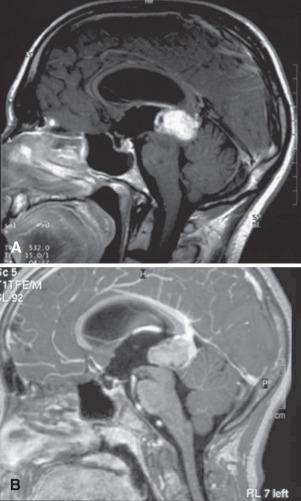
Pineoblastomas are grossly soft, friable, and grayish, with hemorrhagic or necrotic areas. They are large and exhibit a more infiltrative appearance, with an irregular or lobulated shape and possible leptomeningeal dissemination. Hydrocephalus is generally pronounced. On CT, they are hyperdense infiltrative masses, most often without calcifications. On MRI, they appear hypointense to isointense on T1-weighted images and isointense to slightly hyperintense in T2-weighted images. On the CT and MRI, contrast enhancement is slight to moderate and can be homogeneous or patchy ( Fig. 11.1B ).
Neuroimaging data on PPTID are limited. They present as locally invasive or circumscribed pineal masses. On MRI, they usually show hypointensity on T1-weighted images and hyperintensity on T2-weighted images. Contrast enhancement is mostly strong and heterogeneous. “Exploded” calcifications may be observed on CT.
Histopathologic diagnosis is required in the management of nonsecreting tumors of the pineal region (i.e., normal serum α-fetoprotein [AFP], placental alkaline phosphatase [PLAP], and β-human chorionic gonadotropin [β-HCG] levels). Tissue is obtained either by open microsurgery or “minimally invasive” procedures, such as neuroendoscopic or stereotactic biopsy. Tumoral samples obtained by the latter are often small and occasionally contain electrocautery artifacts.
Morphologic features used in classifying and grading PPTs include tumor architecture, cell size, nuclear atypia, and mitotic counts. Pineocytomas are well-differentiated, moderately cellular tumors composed of midsized neoplastic cells resembling pineocytes. These cells are uniform and arranged in a diffuse or loosely lobular growth pattern. The nuclei are round, oval, or sometimes indented, with a thin or “salt and pepper” chromatin. “Pineocytomatous rosettes” (also called pineocytic rosettes ) may be seen and are a distinctive characteristic of pineocytomas ( Fig. 11.2A and B ), the latter of which are typically strongly and diffusely synaptophysin immunoreactive ( Fig. 11.2C ). They consist of large fibrillary areas surrounded by neoplastic cells with club-shaped terminations oriented toward the center, the latter seen on silver stains (Bielschowsky or De Girolami) or with a neurofilament protein immunostain ( Fig. 11.2D and E ). Vascularization consists of thin-walled vessels, and necrosis is not observed. Mitoses are extremely rare and may be completely absent in small specimens.
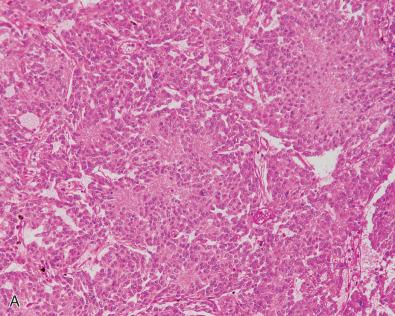
Pineoblastomas are highly cellular, diffuse, dense “small blue cell” tumors ( Fig. 11.3 ). As such, they are indistinguishable from medulloblastomas or other CNS embryonal neoplasms (see Chapter 12 ). Neoplastic cells are small and have scant cytoplasm. The nuclear-to-cytoplasmic ratio is high, and their hyperchromatic nuclei are round to carrot-shaped with frequent molding ( Fig. 11.3A and B ). Mitotic activity is conspicuous, but variable. Homer Wright rosettes may be present. These are usually smaller and tighter than pineocytic rosettes, with the cells forming them generally appearing more primitive. Large areas of necrosis are frequently observed. Vessels are usually thin walled, but focal endothelial proliferation may be seen. Invasion of the adjacent pineal gland and meninges is a common feature. Photoreceptor-type differentiation may be seen as Flexner-Wintersteiner rosettes (rosettes with a true lumen) or fleurettes (bouquet- or fleur-de-lis-like clusters of cells arranged along a segment of external limiting membrane and exhibiting flower-like eosinophilic bulbous terminations).
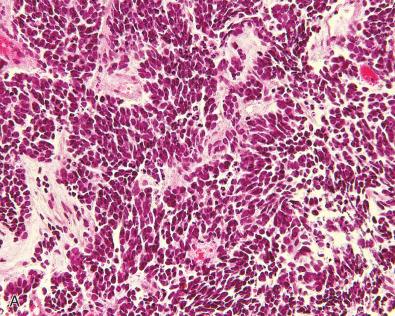
The extremely rare mixed form is characterized by areas of pineoblastoma sharply demarcated from areas of pineocytoma. However, the neoplastic nature of the latter must be clearly demonstrated and not mistaken for infiltrated normal pineal gland ( Fig. 11.4 ).
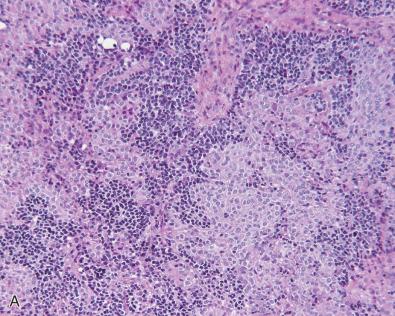
PPTIDs are cellular tumors that exhibit variable architectural features. The two main patterns are diffuse (neurocytoma- or oligodendroglioma-like) ( Fig. 11.5A ) and pseudolobulated, with endocrine-like features and hyalinized vessels. In the latter, the vasculature delineates a tumor with ill-defined lobules ( Fig. 11.5B ). A transitional form has been described and should be diagnosed when areas suggestive of pineocytoma are in continuity with diffuse or lobular areas consistent with intermediate differentiation. Pineocytic rosettes may be seen, but are usually smaller and less eye-catching than those in PCs. Neoplastic cells have less cytoplasm than in pineocytomas, but it is still visible on standard staining. Nuclear atypia is variable and usually moderate. Nuclei are round and uniform, with “salt and pepper” chromatin and often conspicuous, but small, nucleoli ( Fig. 11.5A and B ). The mitotic count varies, although some mitoses are almost always seen ( Fig. 11.5C ). Focal necrosis, leptomeningeal infiltration, and microvascular proliferation may be observed in high-grade PPTIDs, although they otherwise lack the primitive “small blue cell” appearance of pineoblastomas. A pleomorphic variant may be encountered in PCs (see Fig. 11.2F ) and PPTIDs, and is described in the next section.
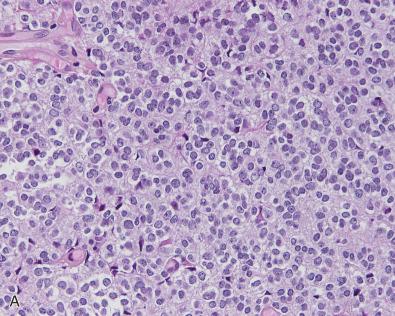
Grading of PPTs remains a matter of debate, and schemes have been regularly revised since 1979. In the 2016 WHO classification, pineocytomas are classified as WHO grade I tumors and pineoblastomas as WHO grade IV tumors. However, no definite grade was assigned to PPTIDs because of the wide range of clinical and biologic behaviors they can exhibit (WHO grades II or III). The 2016 WHO classification recognizes that the intermediate group of PPTIDs encompasses low-grade and high-grade neoplasms. Nonetheless, there is no consensus regarding the diagnostic criteria allowing a clear-cut separation between these two subgroups.
Two features that have been found to correlate with the biologic behavior of PPTs are the proliferation rate, assessed by the mitotic count, silver-stained nucleolar organizer regions (AgNOR) count, or the MIB-1 index, and the degree of neuronal differentiation, assessed by ultrastructural or immunohistochemical studies. At one end of the spectrum is pineocytoma, a nearly nonproliferative neoplasm with a high degree of neuronal differentiation, and at the other is pineoblastoma, a highly proliferative tumor with limited neuronal differentiation.
In one study, histopathologic subtypes, mitotic count, presence of necrosis, and immunopositivity for neurofilament protein (low to high molecular weights) were found to be prognostically significant. These authors proposed a grading scheme ( Table 11.1 ) with the aim of providing criteria for stratifying PPTIDs into two prognostic categories (Jouvet's grading scheme). PPTIDs with fewer than six mitoses/10 high power fields (HPF) and showing neurofilament protein immunostaining of a moderate number of tumoral cells were classed as low grade and may correspond to WHO grade II (grade 2 of Jouvet's classification). Those with fewer than six mitoses with no or rare neurofilament protein immunolabeling or those with six mitoses or more/10 HPF were classified as high grade and may correspond to WHO grade III (grade 3 of Jouvet's classification). Correlation of neurofilament protein staining with patient survival has been confirmed in one study. However, neurofilament protein immunolabeling is subject to considerable interlaboratory variability due to the use of different antibodies and fixation procedures. Therefore, although neurofilament staining is valuable for grading PPTs, the results must be carefully interpreted, taking into account the morphology and mitotic count. The Ki-67 (MIB-1) labeling index is currently the main tool for evaluating proliferation in tumoral pathology, but its role in distinguishing between the different grades of PPTs has not yet been validated. The few studies that have explored the MIB-1 index in the grading of PPTs have shown that the proliferation index is significantly higher in pineoblastomas than in pineocytomas and in disseminated PPTs than in localized PPTs. Proliferation indices are also significantly lower in PPTs with extensive neuronal differentiation than in those with less differentiation, assessed using neurofilament protein alone or the combination of synaptophysin and neurofilament protein stains. Furthermore, three studies have shown that MIB-1 indices vary according to PPT category—for pineocytomas, PPTIDs, and pineoblastomas, MIB-1 indices were 0.5% to 1.6%, 10.1% to 16.1%, and 23.5% to 56%, respectively (see Fig. 11.3D ). Following Jouvet's grading scheme, grade 2 PPTIDs and grade 3 PPTIDs have mean MIB-1 indices ranging from 5.2% to 8.6% and from 11.2% to 19.7%, respectively ( Table 11.1 ) ( Fig. 11.5E and F ).
| Histologic Subtype | Pineocytoma | PPTID (Low Grade) | PPTID (High Grade) | Pineoblastoma | |
|---|---|---|---|---|---|
| Age group | Adulthood | Adulthood | Childhood | ||
| Gross/radiologic appearance | Rounded Well circumscribed Pushing borders |
Not yet clearly determined | Irregular, lobulated Ill-defined margins Parenchymal invasion CSF metastases |
||
| WHO grade | I | II or III | IV | ||
| Jouvet's grading scheme | 1 | 2 | 3 | 4 | |
| Morphology | Pineocytic rosettes Density: moderate Cells: midsized Cytoplasm: clear or eosinophilic with ill-defined cell membranes Nuclei: moderate size, round or indented with inconspicuous nucleoli Chromatin: delicate or “salt and pepper” |
Diffuse or pseudolobulated architecture Transitional: typical PC areas in continuity with PPTID component Density: moderate to high Cells: midsized to small Cytoplasm: still visible Nuclei: uniformly round with moderate anisokaryosis Chromatin: “salt and pepper” with sometimes conspicuous nucleoli |
Patternless architecture Homer Wright rosettes Flexner-Wintersteiner rosettes, fleurettes (extremely rare) Density: high Cells: small Cytoplasm: scant Nuclei: carrot-shaped, round Chromatin: hyperchromatic |
||
| Synaptophysin | Strong, especially in pineocytomatous rosettes | Cytoplasmic, weak to moderate | Weak intensity, diffuse or focal | ||
| Mitoses (per 10 HPF) | 0 | <6 | <6 | ≥6 | Variable |
| Neurofilament protein a | +++ | ++ | ± | ++ | ± |
| Mean Ki-67 immunolabeling index | 0% | 5.2% | 11.2% | 36.4% | |
| Main treatments | Surgery | Optimal treatment not yet known, but including surgery and at least one adjuvant treatment | Surgery/radiotherapy/chemotherapy | ||
| Prognosis | Favorable | Risk of local and delayed relapse | Risk of metastatic dissemination | Dismal | |
| 5-yr survival rate 91% | 5-yr survival rate 74% | 5-yr survival rate 39% | 5-yr survival rate 10% | ||
a Neurofilament protein expression: +++ (presence of numerous positive cells), ++ (presence of focal clusters of positive cells), ± (absence, or presence of rare positive cells).
Mixed PPTs are often characterized by an intermediate proliferation rate between pineocytoma and pineoblastoma but are associated with dissemination potential similar to that for pineoblastomas or high-grade PPTIDs. They have been frequently categorized, perhaps incorrectly, with the PPTIDs, and this has been a source of considerable confusion. In the WHO classification, they are described together with pineoblastomas.
The pleomorphic variant of PPT has been defined for pineocytomas and low-grade PPTIDs (see Fig. 11.2F ) and is characterized by giant cells showing marked pleomorphism, including multinucleated cells with bizarre hyperchromatic nuclei. Although the nuclear atypia may evoke concerns for aggressive potential, this has not been borne out in follow-up studies. On smear preparations or cytologic prints, nuclear atypia ( Fig. 11.6A ) can be mistakenly taken as evidence of a higher grade; conversely, higher-grade tumors often paradoxically display more uniform nuclei ( Fig. 11.6B ).
![Fig. 11.6, Pitfalls in cytologic specimens. (A) Cytologic preparation of a pleomorphic pineocytoma (May, Grunwald, Giemsa [MGG]). In intraoperative diagnosis, marked nuclear atypia may be misinterpreted as indicative of malignancy. (B) Cytologic print of a high-grade PPTID (MGG). Higher-grade tumors show a more uniform nuclear appearance. Fig. 11.6, Pitfalls in cytologic specimens. (A) Cytologic preparation of a pleomorphic pineocytoma (May, Grunwald, Giemsa [MGG]). In intraoperative diagnosis, marked nuclear atypia may be misinterpreted as indicative of malignancy. (B) Cytologic print of a high-grade PPTID (MGG). Higher-grade tumors show a more uniform nuclear appearance.](https://storage.googleapis.com/dl.dentistrykey.com/clinical/PinealParenchymalTumors/5_3s20B9780323449410000114.jpg)
Given the technical challenges of surgically accessing the pineal region, the first histopathologic diagnosis of pineal region tumors is often made using very small stereotactic or neuroendoscopic biopsy specimens. Even an open microsurgery approach is not always straightforward, since the high vascularity of the tumor and the pineal region often requires extensive electrocautery to maintain hemostasis. Using such fragments, the main goal of the pathologist is to assess the sampling adequacy and the nature of the tumor. Diffuse synaptophysin immunoreactivity is good evidence that a pineal region tumor is a PPT. The grading of PPTs based on very small and potentially nonrepresentative samples can be challenging. Clinical data, notably the age of the patient and the neuroradiologic features (e.g., evidence of parenchymal invasion or CSF spread), together with the morphology, mitotic index, immunohistochemical studies, and the MIB-1 index, must all be taken into account when establishing a grade. Fragments with crush or cautery artifacts display retracted cells with hyperchromatic nuclei that may lead to overestimation or underestimation of the mitotic count. In this situation, the MIB-1 index may give a more accurate measure of the proliferation status. In addition, entrapped neurons and neurites in an infiltrative tumor such as pineoblastoma may be misinterpreted as moderate neuronal differentiation, leading to undergrading. However, in such cases, the intensity of staining in entrapped neurons is extremely strong, unlike in tumoral cells where it is usually weaker. Even if mitoses are sparse in the sample, a high MIB-1 index (>35% in our experience) is consistent with the diagnosis of pineoblastoma (see Fig. 11.3D ).
Become a Clinical Tree membership for Full access and enjoy Unlimited articles
If you are a member. Log in here